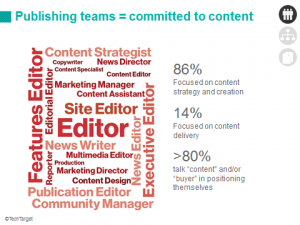 Last Thurs. March 19th, over 100 senior technology marketers converged at TechTarget’s San Francisco ROI Summit in San Mateo for an interactive event filled with market trends, best practices, actionable frameworks, and real-world customer case studies. The event ranged from sessions with global market leaders like Symantec on their approach to driving business growth by optimizing the customer journey to IT Panelists from First Republic Bank giving it to the audience straight on how they conduct research and the data information they need from technology vendors during different stages of their buy cycle.
Last Thurs. March 19th, over 100 senior technology marketers converged at TechTarget’s San Francisco ROI Summit in San Mateo for an interactive event filled with market trends, best practices, actionable frameworks, and real-world customer case studies. The event ranged from sessions with global market leaders like Symantec on their approach to driving business growth by optimizing the customer journey to IT Panelists from First Republic Bank giving it to the audience straight on how they conduct research and the data information they need from technology vendors during different stages of their buy cycle.
A common theme throughout was the power of data and how harnessing it in the right way can make a big impact on ROI with marketing and sales. Organizations that adopt a data-driven approach and leverage that intelligence in their marketing and sales best practices will ultimately win and grow their business.
While there was an abundance of valuable information, below are a few key takeaways:
Listen to what (IT) buyers want
Things kicked off with market research on the current IT landscape. Global IT Budgets are on the rise globally, up 6.7 % in 2015, and there is a big shift in how buyers evaluate vendors and make their IT purchase decisions. It is clear that today’s marketers need to leverage data more than ever before. For instance, today’s IT Buyers want data and content information on solutions that will help them solve technology challenges and help scale their organizations as they grow. Yet, buying teams are first and foremost relying heavily on third-party sources like TechTarget to do their upfront research. One Panelist from Republic Bank commented “Our process went on for months before we engaged with any vendors. In fact, we selected a vendor who wasn’t even on our short list.” His advice was to know the industry you are selling into and understand the criteria buyers are evaluating technology solutions on. He shared for example that in his industry [Banking], they are one of the few industries that buy a lot of infrastructure and have it on premise so it can be run by their own teams. Therefore a vendor pushing and pitching cloud based solutions won’t be effective to them – and having that type of personalized intelligence upfront saves his team a lot of time. He also stated that sales cold-calling rarely works, but noted that once their team engages, vendors who have insights into how and where they’re engaging will definitely give them a leg up and make companies like his more receptive to talking with them.
Access to data intelligence you can leverage into your marketing and sales efforts will empower technology vendors to give buyers what they need and want.
Building a powerful content architecture begins by thinking like a publisher

Building content that won’t get ignored requires thinking like a publisher. When determining the right approach to implement data into your nurture streams, ensure your content is aligned accurately to your buyer’s journey and it must be buyer-centric. People buy based not on who you are but rather what you do. When a buyer references your content he/she needs to immediately be able to associate how your solution(s) maps to their pain point, challenge or need. From there, they need the ability to stay on that journey based on their personalized situation and unique needs.
Try to be a “digital tour guide” by enabling your buyers from search to discovery, first by bringing in people with relevant content and then by helping them continue their journey in a way that is personalized to them. When you build a content architecture you need to factor in volume, but also include quality content and construct it with content that fuels an experience from top to bottom. Think lifecycle, identify influencers, marry buyer’s cares with business goals, and diversify the perspective of the content you share. And use the power of data to inform the content you market.
Build a powerful content foundation that identifies the right prospects, and educates them on your offering so it drives them to your sales team for further engagement. If you plan, build and execute the right content framework and strategy you will be in a position to deliver the best opportunities for your sales team.
Use technology data to optimize the customer journey
May Mitchell, VP Marketing of Symantec, shared best practices on what it means to be market-led and how sales and marketing have to be lock and step throughout the customer journey. Together, these teams should act as partners and be aligned to understand where the market is growing to position and map programs to the customer journey and personas.
Marketing and sales should be also be using technology data at every stage. May stated “The buyer is control now and knows what they want and how to search digitally using third party sources first before ever talking with vendors. They want instant gratification, so content is king and sales relies heavily on marketing for that content.” We have all heard by now that buyers are 70% along in their buy cycle before they engage with vendors. She advises marketers to help buyers out by making content easy to find, and with trusted sources where buyers go to research. Make your content easy to consume to help them make decisions and help them be successful. She emphasized the importance of understanding the customer journey and knowing the right time to inject the next conversation, and to do it on an automated basis.
May concluded that companies that market to personas and their customer’s journey are likely to increase pipeline by 2x—and sales in turn will love you for it!!
Integrate intelligence into the workflow of Marketing and Sales
The message to marketers is that it’s time to stop operating in the dark. On average a buyer is with you 10-15 % of time so you need to know where they are when they aren’t with you. Let’s face it, marketing often operates off very little or limited amounts of information. But imagine having the data that fills in the gap when prospects are not looking at your content, white paper or trial download and the visibility into what activities they are taking. It’s likely that type of data doesn’t exist in within your own ecosystem. Yet knowing this could help your nurture streams get better or find more MQL’s faster across accounts you could be going after.
The ability to access this data across time and accounts and know what marketing actions you could be employing every day could make your marketing more simple, easier and effective. Having this data intelligence and analytics should not require you to change or transform your marketing either. There are things and actions you should be able to do with it out of the gate. Consider for example, an intelligence-driven marketing and sales tool that monitors buyer behavior and helps understand the buying signals and purchase intent of key accounts in key segments. Not only that, it will let you make the most out of your database and avoid missing out on identifying which of your contacts are looking to make a purchase. By seeing where active accounts and teams are spending their time, you wouldn’t need to wait for them to reach out to you – instead, you can intersect them where they are doing research and making decisions. To learn more on this topic, click here.
That’s a recap on some of the takeaways from TechTarget’s San Francisco ROI Summit.
Feel free to share any comments below or connect with me on LinkedIn and Twitter.
Power of data image via Shutterstock.




